The Secret Meeting
On March 17, 1835, Lewis Gunn, a student at the Princeton Theological Seminary, posted a furtive letter to Amos Phelps, an agent for the American Anti-Slavery Society. Gunn was anxious for an abolitionist speaker to visit campus, but the faculty of the seminary directly forbade any discussion of the topic. The local Presbyterian church was equally hostile. Undeterred, Gunn suggested that Phelps arrive in secret and rent the second floor of a house for a private gathering. He asked Phelps to bring tickets, so that they could control access for a small group of sympathetic students. Even writing about the plan was a tremendous risk. “For the sake of the cause of abolition here, as well as my peace while I remain in this place,” he implored, “do not whisper it even that I have had a hand in bringing it about.” A public meeting would have been ideal, but it was impossible. “The difficulty in the way of holding a truly public meeting,” Gunn explained, “is that there are many very wild students in the college from the South, who would like no better frolic than to mob an antislavery man.”[1]
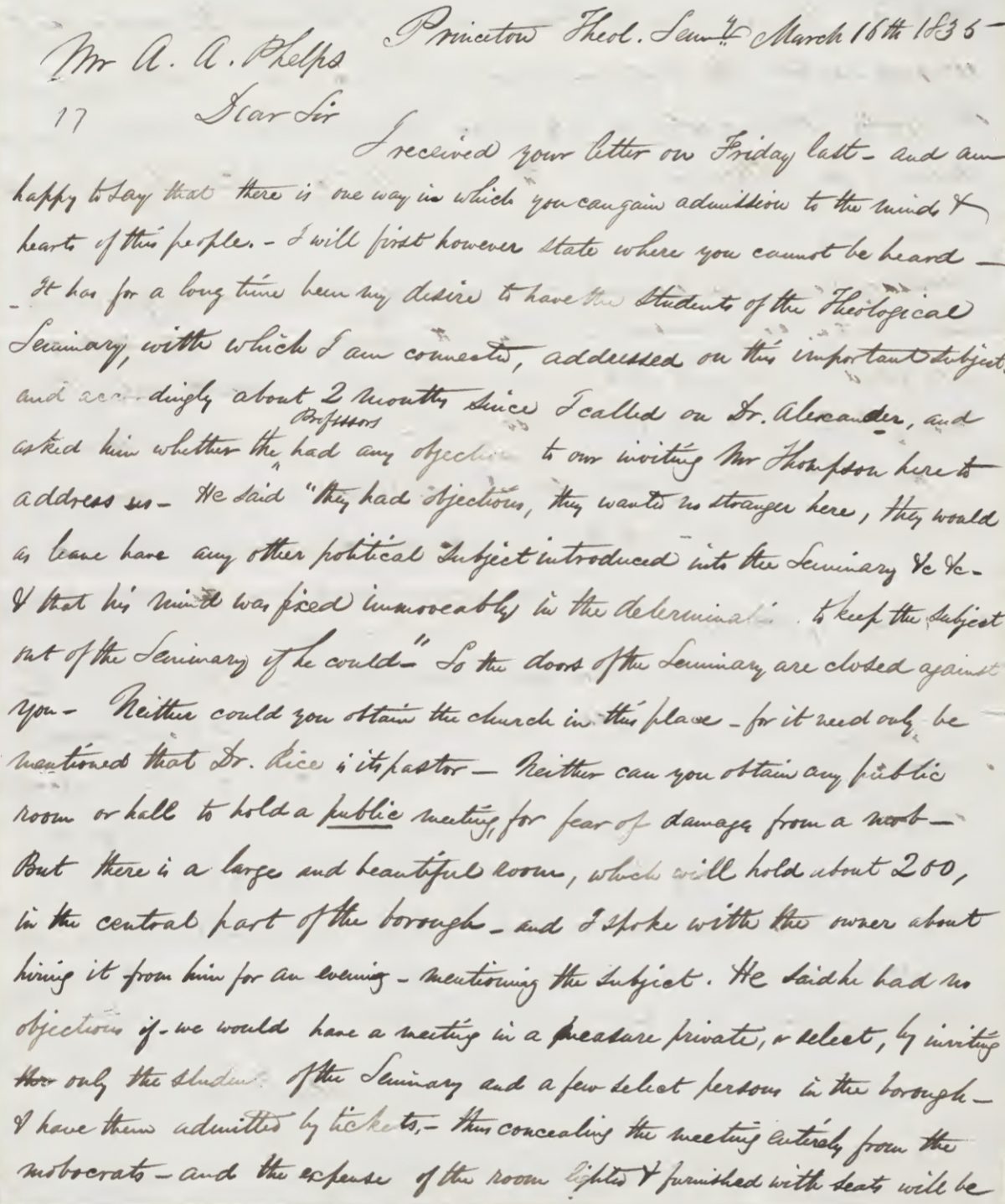
Letter from seminary student Lewis C. Gunn to abolitionist Amos A. Phelps, outlining plans for a clandestine meeting in Princeton.
View Primary Sources
Phelps, a graduate of Yale Divinity School, was no stranger to mob violence. A professional organizer and public speaker, he toured the country establishing local anti-slavery societies. In 1834, he published Lectures on Slavery and its Remedy, a landmark document in the movement for immediate emancipation and equal rights. Like most prominent abolitionists, he suffered multiple attacks over the course of his career. While speaking against slavery in Connecticut, he narrowly avoided serious injury when a crowd pummeled him under a hail of glass and stones. In 1836, a Georgia newspaper offered a bounty of $10,000 for his head. Whether Phelps made the journey to Princeton in 1835 is unclear. If Gunn’s plan was successful, their meeting occurred in secret, with only a select few in town or on campus aware of it. If the meeting did occur, it may have contributed to the birth of a new anti-slavery society in Princeton.[2]
On July 30, 1835, a group of three students composed a letter to William Lloyd Garrison, the editor of the radical abolitionist newspaper the Liberator. They announced the formation of “the Princeton, New Jersey, Young Men’s Anti-Slavery Society,” with the stated goal of “the immediate abolition of Slavery throughout these United States.” They also asked for advice on the best way to participate “in this great work of national reformation.” Garrison published their letter the following week. Although the young men identified themselves as members of “the literary institution of this place,” their names do not correspond with anyone known to be enrolled at the College of New Jersey or the Princeton Theological Seminary. Given the level of opposition on campus and in town, the authors may have used pseudonyms. They may have been students at one of the grammar schools or academies that operated in Princeton at irregular intervals. Or the letter may have been a hoax. There is no evidence that their society continued to function after the summer of 1835. Whatever the case, together with the secret correspondence between Gunn and Phelps, their announcement helped to set the stage for the disaster that followed.[3]
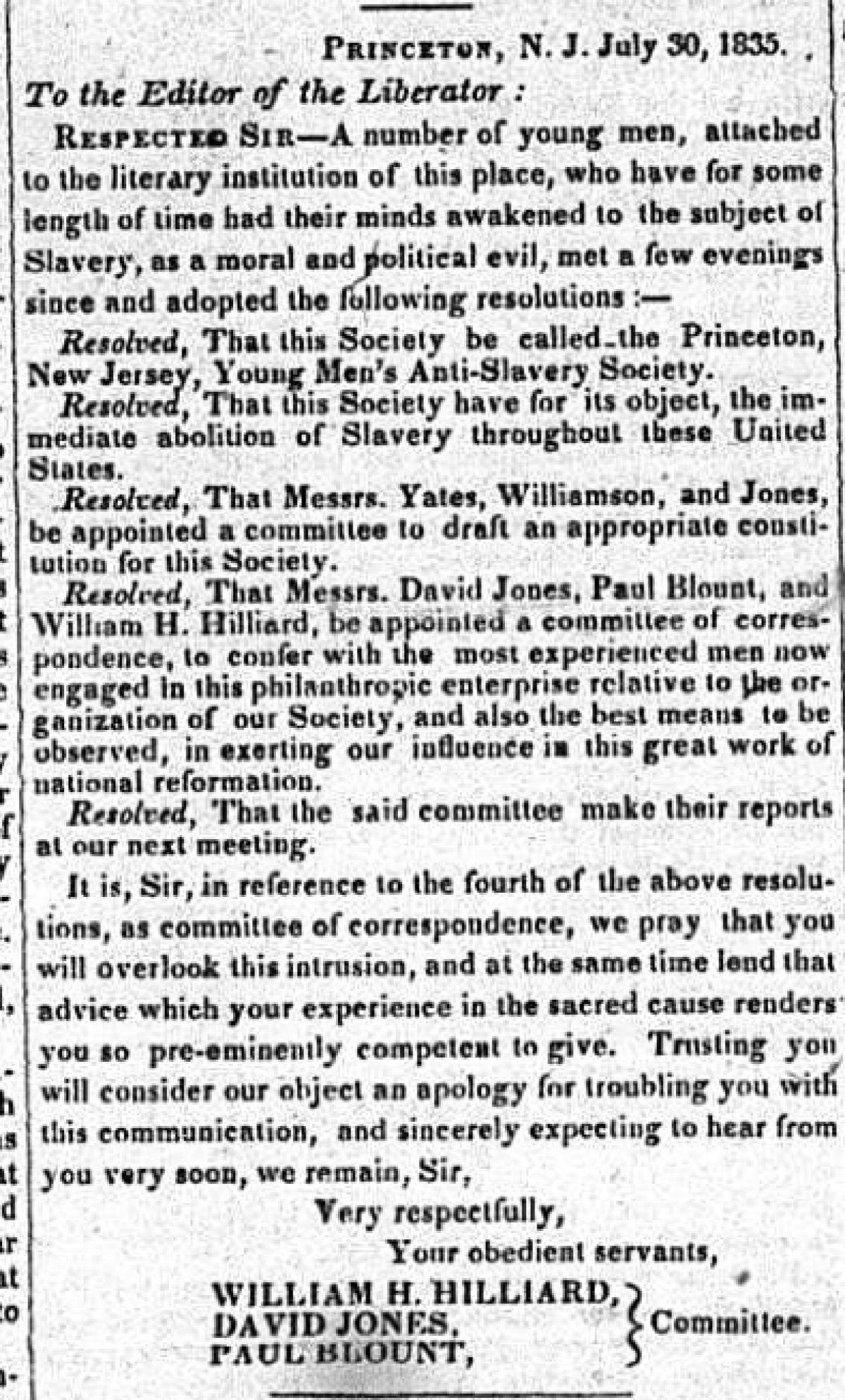
An announcement from the Princeton, New Jersey, Young Men’s Anti-Slavery Society, sent to William Lloyd Garrison, editor of the Liberator.
View Primary Sources
The Lynch Mob
On Friday, September 4, 1835, as summer drew to a close and the College of New Jersey prepared for its annual commencement, word spread across the campus that an abolitionist agitator was in town. According to several eyewitness reports, a group of undergraduates walking down Witherspoon Street—the heart of Princeton’s black neighborhood—noticed a white man in one of the houses, “and upon inquiring, found him to be an abolitionist.” Returning to the gate just outside Nassau Hall, the students gathered their peers, held a meeting, and voted to lynch him. (A form of extrajudicial punishment, lynching included beating, whipping, tar and feathering, hanging, and other forms of abuse, and could lead to a variety of results up to and including death.) A troop of about sixty undergraduates assembled and marched toward Witherspoon Street, which they referred to derisively as “nigger lane.” If the reported numbers are accurate, the group represented almost one third of the entire student population.[4]
The owner of the house attempted to block the horde of angry students at his doorstep. When asked if he was harboring a white man within, “at first being frightened almost to death he answered no, but upon being questioned more closely said yes.” The exact nature of this close questioning is not disclosed—but it could not have been pleasant. Although unnamed in the surviving sources, the homeowner may have been Anthony Simmons, a professional caterer and a prominent member of Princeton’s black community. Simmons donated to the American Anti-Slavery Society in the spring of 1835 and actively supported the Liberator and the Colored American, both abolitionist newspapers. If it was Simmons, despite his relative wealth and influence in the community, he was powerless to stop what happened next.[5]
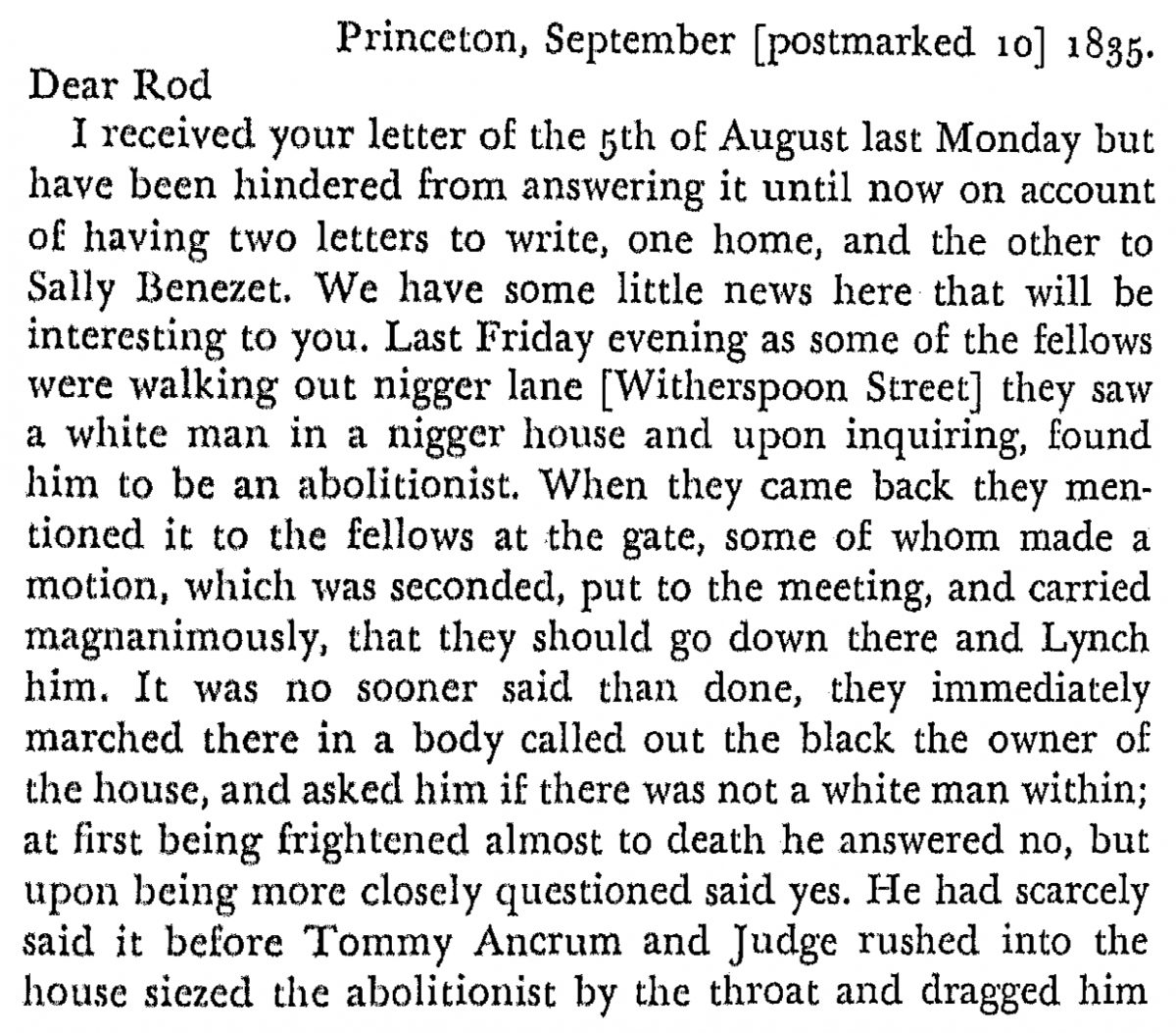
Letter from Gilbert R. McCoy (class of 1837) to Gilbert R. Fox (class of 1835), describing the student-led lynch mob.
View Primary Sources
Freshman Thomas Ancrum (class of 1838) and sophomore Hilliard Judge (‘1837) entered the house, grabbed the white man by the throat and dragged him onto the street. Seizing his papers, they discovered that he was an agent for a number of abolitionist publications, including the Liberator, the Emancipator, and the Philanthropist—the latter about to launch its inaugural issue under the supervision of James Birney (‘1810). Members of the crowd on the street, now joined by some local Princeton residents, grew increasingly irate and began shouting suggestions: “‘Lynch him’, ‘kick him out of town’, ‘kick him to death’, ‘hang him’, tar and feather him.” At one point, if contemporary reports can be trusted, even a local black man joined in the assault. If true, he may have hoped to gain friends on campus by his show of loyalty.[6]
The victim pled for his life and told the group that he had a wife and a family in Philadelphia who needed his support. His appeal worked. According to one witness, the students “told the old fellow that they would let him go upon condition that he renounced abolition and swore by all that is holy he would have nothing more to do with it.” The terrified captive complied with their demand. For good measure, the leaders of the group decided to burn his subscription book and to parade him through the center of town, on their way to the Princeton Theological Seminary. When they arrived at their destination, they “called to the Seminarians that here was one Abolitionist & they might look out to be served in the same manner if they caught any of them.” Their actions could be interpreted as a warning to Lewis Gunn and his supporters about their earlier clandestine activities. Taking their hostage to the edge of town, on the road to Philadelphia, the students “told him to run for his life” and gave chase until they lost him in the woods. Their victim’s identity, and his ultimate fate, remains unclear.[7]
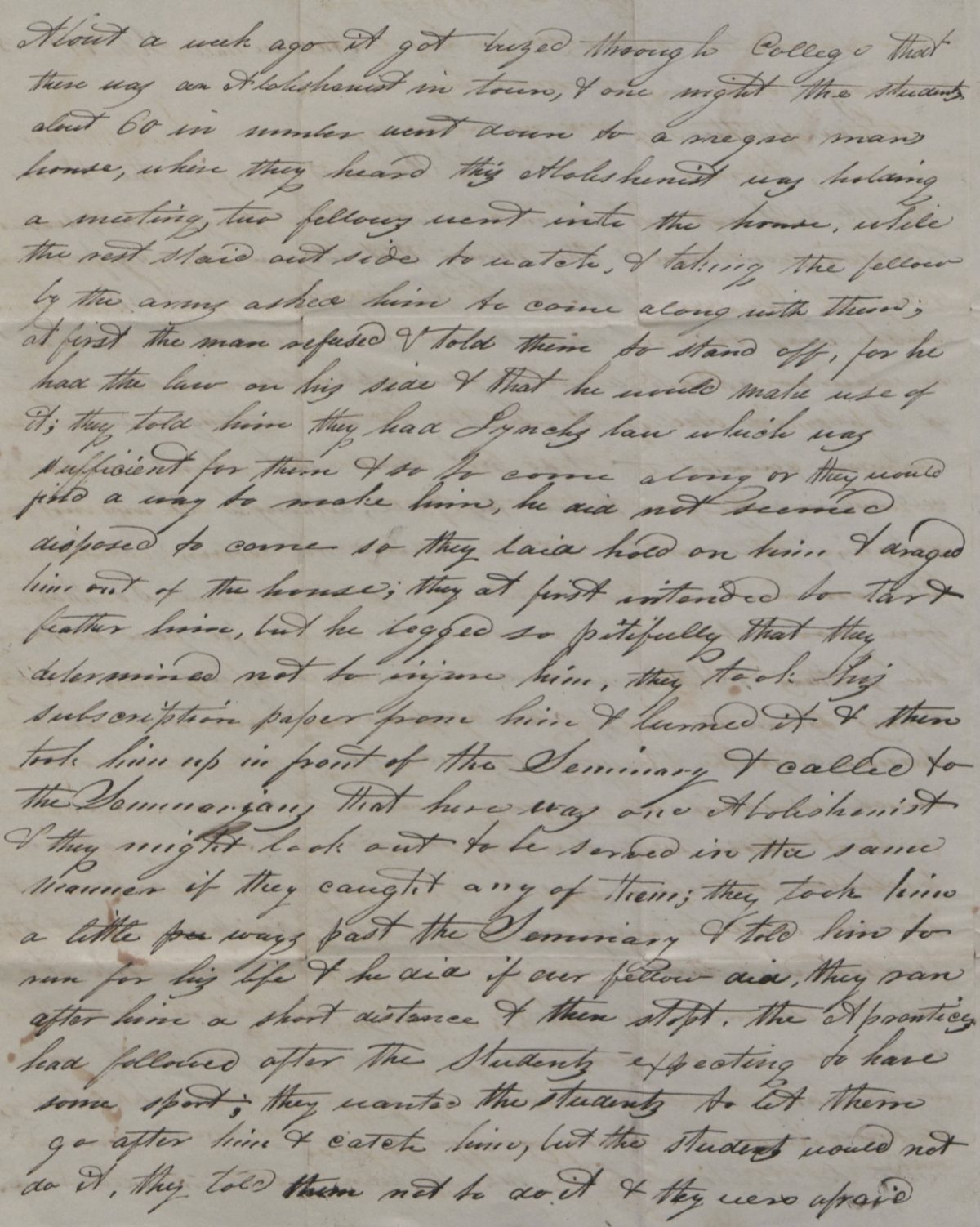
Letter from John Witherspoon Woods (class of 1837) to his mother, describing the student-led lynch mob.
View Primary Sources
Mob violence of this sort was not unusual in antebellum America. Historian David Grimsted counts thirty-five anti-abolition riots in the summer of 1835 alone. Abolitionist newspapers attracted special attention, and their presses were attacked and destroyed at least thirteen times during this period. Encouraged by hostile or indifferent administrators and faculty members, violence occasionally erupted on college campuses. Students at Wesleyan University assaulted a black abolitionist in 1833 and drove him out of the school. A well-armed mob of townspeople attacked black students and destroyed the interracial Noyes Academy in August 1835. Later that same month, a southern student at Amherst College bludgeoned a fellow student who supported abolition. But Princeton may be unique—the only case in American history where undergraduates organized and led an assault on a visiting white abolitionist.[8]
The Aftermath
Newspapers across the country published a condensed version of the story. Southern papers applauded the action, while New Jersey papers celebrated the mob’s sense of decorum and restraint. “We rejoice for the credit of our borough that nothing more serious was attempted,” opined the Princeton Whig. None of the published reports mentioned that Princeton undergraduates had spearheaded the assault. College faculty and administrators remained quiet throughout the affair. Surviving records indicate no disciplinary action taken against any of the ringleaders or their accomplices. There was no attempt even to investigate the incident or to identify the offenders. The faculty’s deep commitment to colonization and equally deep opposition to abolition were well known, and their silence gave tacit approval to the student vigilantes.[9]
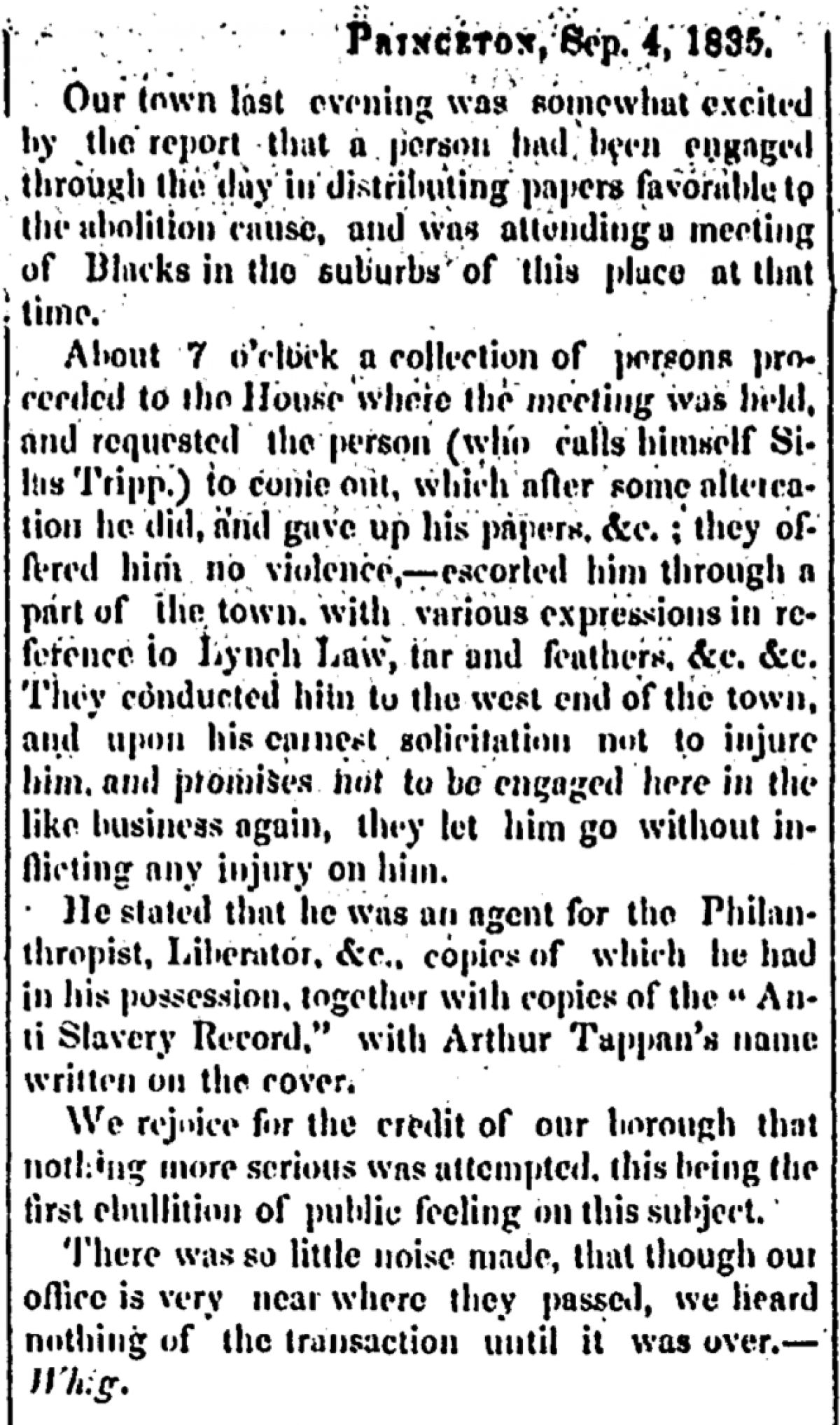
A report on the anti-abolition mob, from the Princeton Whig, reprinted in the Emporium and True American (Trenton, NJ).
View Primary Sources
The incursion into Princeton’s black neighborhood, the assault, and the inaction of the college leadership, underscored the school’s dual commitment to slavery and white supremacy. One month later, the faculty reaffirmed their position. In October 1835, New York banker and abolitionist David Leavitt donated $1,000 to the College of New Jersey. No doubt aware of recent events, Leavitt offered the windfall "on condition that students be admitted irrespective of color, that all be entitled to the like privileges, and that official notice be published in the New York Evangelist and Observer." His request was denied.[10]
Both students who led the attack were from South Carolina. Eighteen-year-old Thomas Ancrum lived with College Vice President John Maclean Jr., while attending classes. His classmates described him as “a genial, warm-hearted, whole-souled, impulsive friend and companion, beloved by everybody.” Ancrum faced no disciplinary action for his role in the mob. In March 1836, however, he and another student were suspended “for going to the tavern without permission.” At the end of June 1836, Ancrum withdrew from the school in order to take charge of his family’s plantation. He returned to Princeton in September to attend his brother’s graduation at the annual college commencement. While there, he physically assaulted black abolitionist and Princeton Seminary alumnus Theodore Wright. Again, he faced no repercussions from either college administrators or town officials. The school’s tacit endorsement of the first attack directly enabled the second. By 1850, Ancrum and his brother owned over 200 slaves on their South Carolina estate. By the time of the Civil War, Ancrum wielded a substantial fortune. He participated in the siege of Fort Sumter in April 1861 and served as a recruiting officer for the Confederate Army.[11]
Sixteen-year-old Hilliard Judge followed a similar pattern. College officials suspended him in July 1835 for an unauthorized trip to the local tavern. The faculty restored him in August, less than a month before he helped to organize the lynch mob. Like Ancrum, he faced no repercussions for his actions from either college or civil authorities. In April 1837, Judge was dismissed again for “appearing in the College entry with two or more loaded pistols and a dirk upon him, and attempting repeatedly to fire one of his pistols at a College officer who was present.” The motivation for the attack is unclear. The faculty let him off easy, citing “palliating circumstances,” and awarded his degree in 1840. Emboldened by his actions at Princeton, Judge moved to Alabama and became involved in proslavery politics. “The public mind, is rapidly being prepared for what must come at last,” he wrote to Senator John C. Calhoun in 1849, “the dissolution of the Union.” At the time of his death the following year, Judge owned at least 20 slaves.[12]
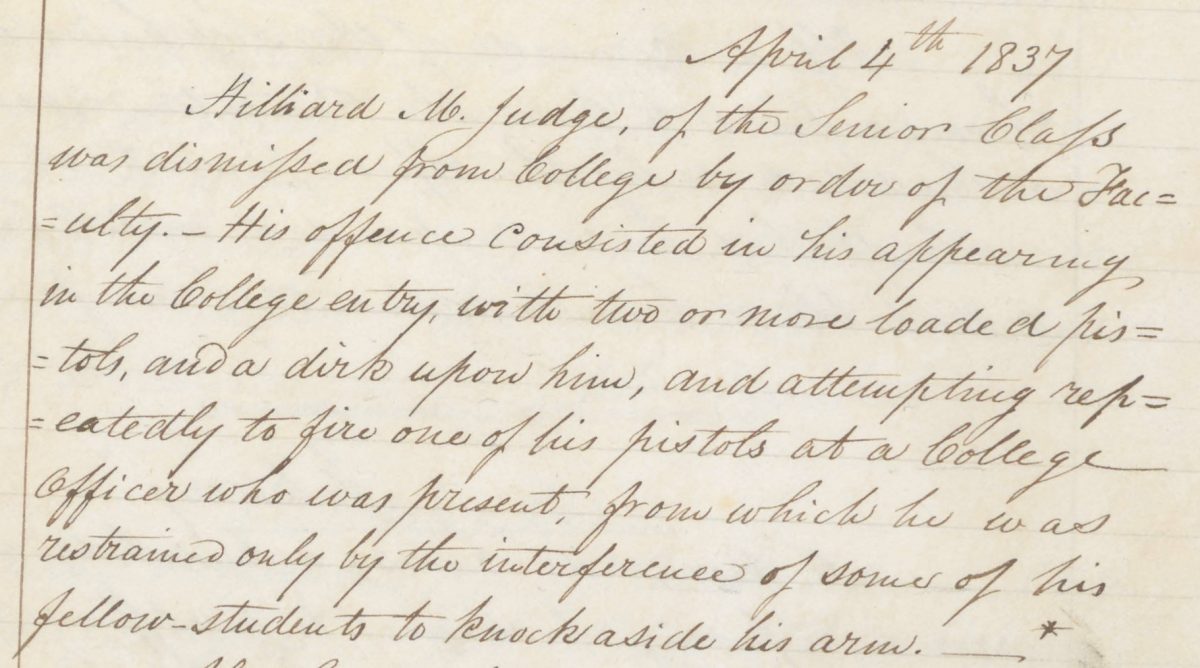
Dismissal of Hilliard M. Judge (class of 1837) for "attempting repeatedly to fire one of his pistols at a College officer." Judge received his degree three years later.
View Primary Sources
The identity of the students’ abolitionist victim is difficult to determine. Newspapers reported his name as “Silas Tripp,” which may have been a pseudonym. No such name is listed in any of the leading abolitionist publications of the era. Descriptions in contemporary reports are vague and contradictory. Tripp told his attackers that he was married and lived in Philadelphia. On the day following the attack, however, unspecified sources informed the students that he was single and from New York. The victim may have been Amos Phelps, the representative from the American Anti-Slavery Society, who would assume the editorship of the New York City-based Emancipator the following year. At the time of the attack, Phelps was married and had a child. Or the victim may have been Lewis Gunn, the organizer of the secret meeting in Princeton, who was born in New York and graduated from Columbia. He was single at the time of the attack. If the victim was Gunn, it might explain why the students felt the need to parade him in front of the Princeton Theological Seminary.
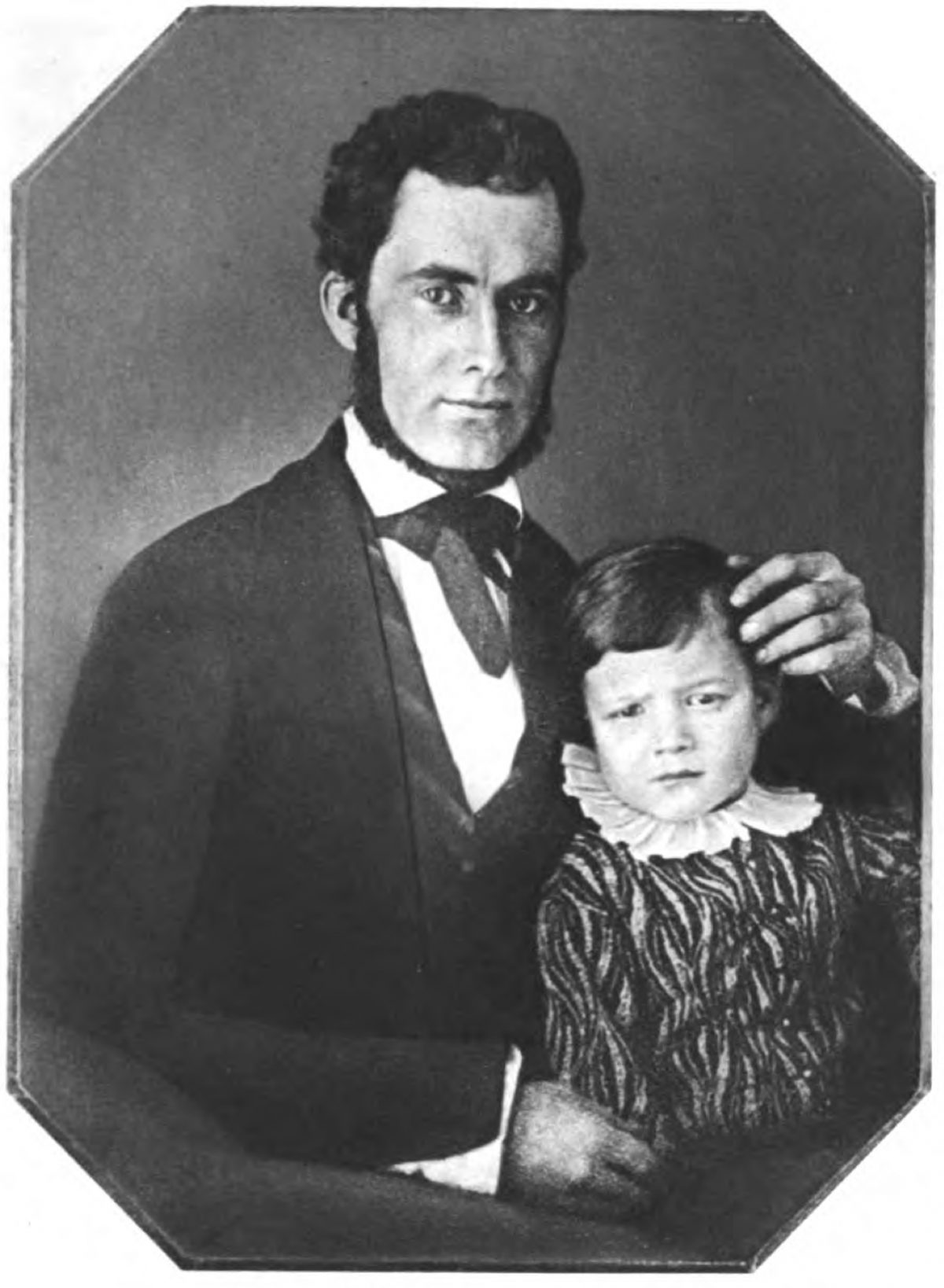
A portrait of seminary student and abolitionist Lewis C. Gunn with his young son (1840s).
View Primary Sources
Lewis Gunn withdrew from the Seminary before the end of 1835, citing ill health. It is probably safe to assume that the anti-abolition activities of the undergraduate students and faculty contributed to his decision. He moved to Philadelphia, the alleged home of the mysterious Silas Tripp, soon thereafter. Perhaps inspired by events at Princeton, Gunn abandoned secrecy altogether and started a printing business, specializing in abolitionist literature. He also helped to organize a boycott of slave-produced goods. His experience at Princeton, and the climate of fear and intimidation encouraged by the college and seminary students and leaders, probably helped to shape his actions in this endeavor as well. Responding to criticism that the boycott was impractical, Gunn argued that it would keep the issue of slavery at the forefront of the public consciousness. “Free discussion,” he wrote, “is the vital air of abolitionism.”[13]
In November 1837, Gunn’s seminary classmate, Elijah Lovejoy, was shot to death while defending his printing press from an anti-abolition mob in Illinois. Several months later, as violence and repression continued to spread, Gunn spoke on the right of free discussion in front of a large audience in the recently-constructed Pennsylvania Hall in Philadelphia. There is no doubt that his Princeton experience informed his argument. “There are two and a half millions of slaves who are never allowed to speak in their own behalf, or tell the world freely the story of their wrongs,” he announced:
There are also half a million of so called free people of color, who are permitted to speak with but little more liberty than the slaves. Nor is this all. Even those who stand up in behalf of the down-trodden colored man, however white their skins may be, are slandered, persecuted, mobbed, hunted from city to city, imprisoned, and as in the case of the lamented Lovejoy, put to death!
Without freedom of speech, Gunn argued, “we ourselves are slaves.” Two days later, encouraged by politicians and local officials, an anti-abolition mob burned Pennsylvania Hall to the ground and attacked black families throughout the city.[14]
About the Author
Joseph Yannielli received his PhD from Yale and was the Perkins Postdoctoral Fellow in the Princeton Humanities Council. His work focuses on the history of slavery and abolition, with a special focus on America, West Africa, and the wider world during the nineteenth century. His other areas of interest include political and social movements, missionaries and religion, capitalism and globalization, and the United States in the world. At present, he is completing a book about the Mendi Mission and the role of Africa in the American abolition of slavery. He was the first project manager and lead developer of the Princeton & Slavery Project website, as well as several other digital history projects.
View all stories by Joseph Yannielli »
References
[1]
Lewis C. Gunn to Amos A. Phelps, 16 March 1835, MS A.21 v.5, p.20, Amos A. Phelps Correspondence, Rare Books and Manuscripts Department, Boston Public Library (Boston, MA); James H. Moorhead, “Slavery, Race, and Gender at Princeton Seminary: The Pre-Civil War Era,” Theology Today 69 (October 2012): 274-288.
⤴
[2]
Amos A. Phelps, Lectures on Slavery and its Remedy (Boston: New-England Anti-Slavery Society, 1834); Edward A. Phelps, “Rev. Amos A. Phelps – Life and Extracts from Diary,” MS 1037, Amos A. Phelps Correspondence, Rare Books and Manuscripts Department, Boston Public Library (Boston, MA).
⤴
[3]
William H. Hilliard, David Jones, and Paul Blount to William Lloyd Garrison, 30 July 1835, in the Liberator, 8 August 1835; John Frelinghuysen Hageman, History of Princeton and Its Institutions, vol. 2 (Philadelphia: J. B. Lippincott & Co., 1879), 217-227.
⤴
[4]
My reconstruction of this event is based on three manuscript letters: Thomas M. Clark to John M. Clapp, 8 September 1835, Spared & Shared 4, accessed 1 September 2017, http://sparedshared4.wordpress.com/letters/1834-thomas-march-clark-to-john-milton-clapp/; Gilbert R. McCoy to Gilbert R. Fox, [10] September 1835, in the Princeton University Library Chronicle 25 (Spring 1964): 231-235; John W. Woods to Marianne Woods, 14 September 1835, folder 10, box 7, John Witherspoon Woods Letters, Student Correspondence and Writings Collection (AC334), Princeton University Archives, Department of Rare Books and Special Collections, Princeton University Library (Princeton, NJ).
⤴
[5]
McCoy to Fox, [10] September 1835, Princeton University Library Collection; The Anti-Slavery Record, vol. 1 (New York: R. G. Williams, 1835), 84; “List of Letters,” Liberator, 12 July 1834; “Letter from Mr. Johnson,” Colored American, 30 January 1841; Rina Azumi, “John Anthony Simmons,” Princeton & Slavery Project, accessed 1 July 2017, slavery.princeton.edu/john-anthony-simmons.
⤴
[6]
McCoy to Fox, [10] September 1835, Princeton University Library Collection; Princeton Whig, 8 September 1835.
⤴
[7]
McCoy to Fox, [10] September 1835, Princeton University Library Collection; Woods to Woods, 14 September 1835, Student Correspondence and Writings Collection.
⤴
[8]
David Grimsted, American Mobbing, 1828-1861: Toward Civil War (New York: Oxford University Press, 1998), 4, 35; “The Reign of Prejudice,” Abolitionist 1 (November 1833): 175; Craig Steven Wilder, Ebony & Ivy: Race, Slavery, and the Troubled History of America’s Universities (New York: Bloomsbury Press, 2013), 271-272.
⤴
[9]
Princeton Whig, 8 September 1835; Trenton Emporium & True American, 12 September, 1835; Charleston Courier, 17 September 1835.
⤴
[10]
“Subscription $1000,” folder 5, box 23, Office of the President Records (AC #117), Princeton University Archives, Department of Rare Books and Special Collections, Princeton University Library (Princeton, NJ).
⤴
[11]
William Edward Schenck, Biography of the Class of 1838 of the College of New Jersey, at Princeton, N.J. (Philadelphia: Jas. B. Rodgers Printing Co., 1889), 163; Faculty Meetings and Minutes, 29 March, 27 June 1836, vol. 4, Office of Dean of the Faculty Records (AC118), Princeton University Archives, Department of Rare Books and Special Collections, Princeton University Library (Princeton, NJ); “Shameful Outrage at Princeton, N.J.,” Emancipator, 27 October 1836; 1850 Federal Census (Slave Schedule), FamilySearch, accessed 30 June 2017, https://familysearch.org/ark:/61903/1:1:MVZB-P3B; C. Vann Woodward, ed., Mary Chesnut’s Civil War (New Haven, CT: Yale University Press, 1981), 70.
⤴
[12]
Faculty Meetings and Minutes, 21 July, 10 August 1835, vol. 3, Office of Dean of the Faculty Records (AC118), Princeton University Archives, Department of Rare Books and Special Collections, Princeton University Library (Princeton, NJ); Faculty Meetings and Minutes, 4 April 1837, vol. 4, ibid.; Hilliard M. Judge to John C. Calhoun, 29 April 1849, in The Papers of John C. Calhoun, vol. 26, ed. Clyde N. Wilson and Shirley Bright Cook (Columbia: University of South Carolina Press, 2001), 385; 1850 Federal Census (Slave Schedule), FamilySearch, accessed 30 June 2017, https://familysearch.org/ark:/61903/1:1:MV8H-CNG.
⤴
[13]
Anna Lee Marston, ed., Records of a California Family: Journals and Letters of Lewis C. Gunn and Elizabeth Le Breton Gunn (San Diego: n.p., 1928), 4-5; Lewis C. Gunn, Address to Abolitionists (Philadelphia: Merrihew and Gunn, 1838), 12.
⤴
[14]
History of Pennsylvania Hall, which was Destroyed by a Mob, on the 17th of May, 1838 (Philadelphia: Merrihew and Gunn, 1838), 62-64.
⤴











